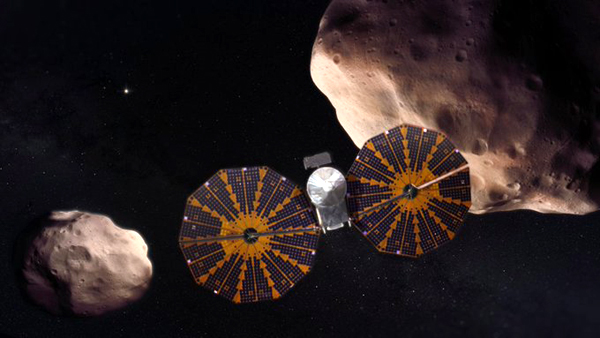
Lockheed Martin
NASA’s Lucy Stretches Its Wings in Successful Solar Panel Deployment Test (News Release)
NASA’s Lucy spacecraft has successfully completed thermal vacuum testing of both solar panels, the final step in checking out these critical spacecraft components in preparation for launch this fall. Once the Lucy spacecraft’s solar panels are attached and fully extended, they could cover a five-story building.
Lucy, the 13th mission in NASA’s Discovery Program, requires these large solar panels as it will operate farther from the Sun than any previous solar-powered space mission. During its 12-year tour of the Trojan asteroids, the Lucy spacecraft will operate a record-breaking 530 million miles (853 million km) from the Sun, beyond the orbit of Jupiter.
“The success of Lucy’s final solar array deployment test marked the end of a long road of development. With dedication and excellent attention to detail, the team overcame every obstacle to ready these solar panels,” said Matt Cox, Lockheed Martin’s Lucy program manager, in Littleton, Colorado. “Lucy will travel farther from the Sun than any previous solar-powered Discovery-class mission, and one reason we can do that is the technology in these solar arrays.”
The solar arrays, manufactured by Northrop Grumman in Goleta, California, will be supplying power to the spacecraft and its instruments throughout the 12-year mission. The solar panels need to supply around 500 watts, about equivalent to the energy needed to run a washing machine. Despite this relatively modest need, the solar panels must be large as they need to operate so far from the Sun.
“At about one hour after the spacecraft launches, the solar panels will need to deploy flawlessly in order to assure that we have enough energy to power the spacecraft throughout the mission,” said Principal Investigator Hal Levison of the Southwest Institute in Boulder, Colorado. “These 20 minutes will determine if the rest of the 12-year mission will be a success. Mars landers have their seven minutes of terror, we have this.”
Solar array deployment tests occurred between December 2020 and February 2021 in the 29-foot-by-65-foot (8.8-meter-by-19.8-meter) thermal vacuum chamber at Lockheed Martin Space, where the spacecraft is currently undergoing assembly, launch, and testing operations.
Though when folded up the solar panels are a mere 4 inches (10 cm) thick, once expanded each solar panel has a diameter of nearly 24 feet (7.3 meters). What is more, the solar arrays can’t support their own weight of 170 pounds (77 kg) each in Earth gravity, so a special precision weight offload device is employed inside the chamber for additional support.
“In spite of their complexity and size, the mechanical deployment of the arrays executed flawlessly, said Donya Douglas-Bradshaw, Lucy project manager from NASA’s Goddard Space Flight Center in Greenbelt, Maryland. “The ingenuity and innovation of the team is truly remarkable!”
These key tests bring the spacecraft one step closer to launch readiness. The Lucy spacecraft will be shipped to NASA’s Kennedy Space Center in Florida this summer to ready it for launch when its window opens in the pre-dawn hours of Oct. 16, 2021.
Southwest Research Institute’s Hal Levison and Cathy Olkin are the principal investigator and deputy principal investigator of the Lucy mission. Goddard provides overall mission management, systems engineering and safety and mission assurance. Lockheed Martin Space is building the spacecraft. Lucy is the 13th mission in NASA’s Discovery Program. NASA’s Marshall Space Flight Center in Huntsville, Alabama, manages the Discovery Program for the agency’s Science Mission Directorate in Washington, D.C.
Source: NASA.Gov
****

NASA’s Goddard Space Flight Center / Conceptual Image Lab / Adriana Gutierrez

No comments:
Post a Comment